GRALISTAIR
Established Member
Will the piles be driven deeper or stay as they are?
They'll be driven deeper unless the ground conditions don't allow for itWill the piles be driven deeper or stay as they are?
Do they then cut to size?They'll be driven deeper unless the ground conditions don't allow for it
Generally not, as the pile is designed to be a certain depth in the ground. Additionally, the top of the pile includes the fixing arrangements for attaching the masts, so that ideally wouldn't be cut off. There are ways to cut the piles down and utilise a pile cap, but usually a concrete collar will be used to ensure enough non-effective depth. If this isn't viable then the structure position will have to be redesigned. If the whole area has awkward ground conditions that don't allow for deep piling, a gravity pad can be used insteadDo they then cut to size?
Interesting, thank you.Generally not, as the top of the pile includes the fixing arrangements for attaching the masts, so that can't be cut off.
Usually a concrete collar will be used to ensure enough non-effective depth. If this isn't viable then the structure position will have to be redesigned. If the whole area has awkward ground conditions that don't allow for deep piling, a gravity pad can be used instead
Which side of the B582 bridge - north or south?Large concrete foundation being constructed at Wigston Sth guess for a TSC
I would expect north. Where there's a Y-shaped junction like Wigston South, I would expect to see a TSC placed so that (in an idealised future situation where all routes are electrified) either arm of the Y can be switched off, leaving the other arm and the stem still live.Which side of the B582 bridge - north or south?
No worries.
Elsewhere, on a more OLE-related front, I did a bit of a photo reccy yesterday morning and can report the following:
Photos to follow.
- The "Desborough Gap" has been properly closed now with the installation of the boom on the mid-point anchor portal.
- An additional mast (possibly for AT feeding) has gone up south of the cluster of 4 already in Braybrooke ATFS compound.
- The ATF anchor south of Little Bowden FB (SPC3-31AA) on the UM has now been installed; its number is SPC3/132.596/UM. No brackets on it yet except for the ATF anchor itself.
- Not much of a change in the Kibworth area, except for the installation of more vehicle barriers next to the piles.
- Most masts (except for some near the old station) are up in the Gt Glen area.
- Piles are now up near Kilby Bridge Jn!
But as we saw on Manchester to Preston, that starts putting up cost very quickly.Generally not, as the pile is designed to be a certain depth in the ground. Additionally, the top of the pile includes the fixing arrangements for attaching the masts, so that can't be cut off.
Usually a concrete collar will be used to ensure enough non-effective depth. If this isn't viable then the structure position will have to be redesigned. If the whole area has awkward ground conditions that don't allow for deep piling, a gravity pad can be used instead
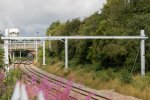
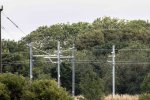
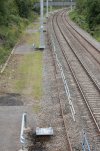
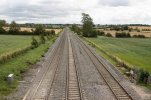
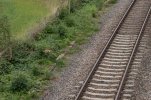
At one time, in the days of the old 'Pole routes' for telegraph, block instruments and the like, quite elaborate precautions were taken where high-voltage power lines crossed the railway, with additional earth wires or even earthed metal mesh over the pole route to protect it from contact with any HV cable that broke.As promised, some photo updates from last week (which might now be out of date!)....
Secondly, the cantilevers around the powerline crossing east of Desborough have been installed, with both Earth Wires and the DM ATF now run. (Here, the DM EW & ATF were temporarily hung at the time; this is likely to have been remedied in the week since I took the picture.)
View attachment 140020
Think it's the improved fault detection. A lot of the time now the ATFs go to ground (in the most literal sense) and run as cables in troughs beneath powerline crossings, which minimises the number of conductors having to be repaired.At one time, in the days of the old 'Pole routes' for telegraph, block instruments and the like, quite elaborate precautions were taken where high-voltage power lines crossed the railway, with additional earth wires or even earthed metal mesh over the pole route to protect it from contact with any HV cable that broke.
I've never seen any similar protection in recent years where a high-voltage crosses a railway line, electrified or not. Are the power lines more reliable, or does improved fault detection mean that such protection is not considered to be needed?
Isn't there a big difference between power wiring, which is designed to cope with high fault currents and to protect itself from further damage away from the site of the accident, and bare signal wires that can carry very dangerous voltages into a little box with people in it?Think it's the improved fault detection. A lot of the time now the ATFs go to ground (in the most literal sense) and run as cables in troughs beneath powerline crossings, which minimises the number of conductors having to be repaired.
Think it's the improved fault detection. A lot of the time now the ATFs go to ground (in the most literal sense) and run as cables in troughs beneath powerline crossings, which minimises the number of conductors having to be repaired.
Thanks for the comments. Telephones, block instruments and the like were, in many cases, fitted with 'lightening arresters' to earth any major voltage surge. Presumably modern and probably screened cables in troughing is less likely to be affected.Isn't there a big difference between power wiring, which is designed to cope with high fault currents and to protect itself from further damage away from the site of the accident, and bare signal wires that can carry very dangerous voltages into a little box with people in it?
Yes, added to the fact that increasingly, the majority of telecom lines away from the immediate vicinity of the end users use fibre cabling, which is virtually immune from high voltage/current discharges to ground.Thanks for the comments. Telephones, block instruments and the like were, in many cases, fitted with 'lightening arresters' to earth any major voltage surge. Presumably modern and probably screened cables in troughing is less likely to be affected.
I've also heard that high voltage national grid power lines can have fault detection that senses a massive phase imbalance, such as would be when an overhead cable breaks. Given the height above ground that they are suspended, high speed breakers could probably remove the power before the cable actually hits the ground.Think it's the improved fault detection. A lot of the time now the ATFs go to ground (in the most literal sense) and run as cables in troughs beneath powerline crossings, which minimises the number of conductors having to be repaired.
You make me think, another advantage is not attractive to cable thieves.Yes, added to the fact that increasingly, the majority of telecom lines away from the immediate vicinity of the end users use fibre cabling, which is virtually immune from high voltage/current discharges to ground.
== Doublepost prevention - post automatically merged: ==
I've also heard that high voltage national grid power lines can have fault detection that senses a massive phase imbalance, such as would be when an overhead cable breaks. Given the height above ground that they are suspended, high speed breakers could probably remove the power before the cable actually hits the ground.
Sadly, cable thieves tend not to know which are the valuable cables and which aren't until after they've sliced through the whole lot to get at them.You make me think, another advantage is not attractive to cable thieves.
Ah, of course. Not really interested in carrying out the least possibly intrusive investigation are they I suppose. The higher the voltage the better would be a solution - they would only cut wires once........Sadly, cable thieves tend not to know which are the valuable cables and which aren't until after they've sliced through the whole lot to get at them.
Having arrived at work one morning to find a hacksaw buried in the insulation of one of our 11,000 volt cables I can confirm that this does happen. Fortunately (or unfortunately) the saw had got stuck in the insulation. A couple more strokes and the toe rag would have been up for a Darwin award.Ah, of course. Not really interested in carrying out the least possibly intrusive investigation are they I suppose. The higher the voltage the better would be a solution - they would only cut wires once........
According to Network Rail this is what is planned for next weekend.I notice next weekend there is engineering works between Kettering and Leicester, with Market Harborough not being served. Is this when the gantries will be installed at Kilby Bridge I wonder?
Well, I've noticed that on the full weekend closures, bridges tend to be demolished, so it could be:According to Network Rail this is what is planned for next weekend.
Market Harborough to Great Bowden
description
SPC3 83m 0ch - 85m 0ch
What we will be doing:
We will be installing trackside posts and overhead wires
When will we be working day and night between:
Fri 4 August 2023 - Mon 7 August 2023
---------
Newton Harcourt to Wigston
description
Ref No: SPC3 92m 20ch - 95m 20ch
What we will be doing:
We will be carrying out piling work to install
foundations in the ground to support new
overhead line equipment (OLE). Piling involves
driving the piles deep into the ground.
Our specialist teams will be working between day and night shifts between:
Fri 4 August 2023 - Mon 7 August.
-------
Kibworth
description
SPC3 86m 0ch - 90m 0ch
What we will be doing:
We will be installing trackside posts and overhead wires
When will we be working:
22:00 Fri 4 August 2023 - 08:00 Mon 7 August 2023
--------
Market Harborough to Kibworth
description
SPC3 80m 10ch - 90m 0ch
What we will be doing:
We will be installing trackside posts and overhead wires
When will we be working day and night from:
Fri 4 August 2023 - Mon 7 August 2023
When I posted this I hadn't noticed that there's another item on page 15 saying it came down to spending money on either MML or the Ely enhancement. I'll post more in an Ely thread.An item on page 13 of the August Modern Railways says that the government has committed itself to MML electrification, dismissing the recently discussed threat that it might stop at Wigston in order to fund HS2.
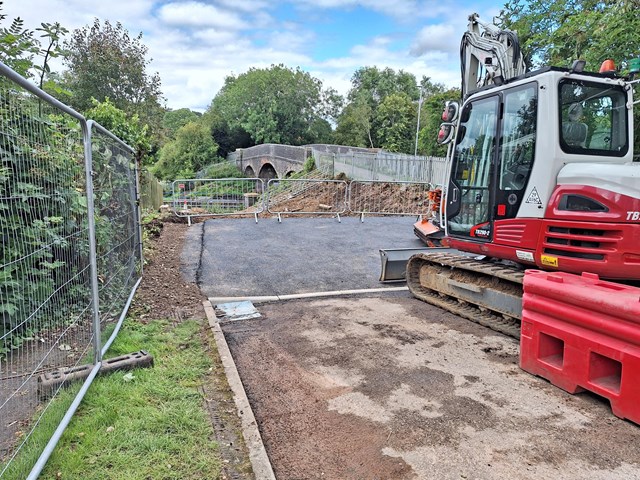
Construction of a temporary bridge in Kibworth has begun whilst essential work to adapt the existing bridge takes place, paving the way for a fully electrified railway between Kettering and Wigston.
School Road bridge will be demolished this Autumn, before being reconstructed to provide the clearance needed for overhead wires to pass underneath.
The wires will eventually power electric and bi-mode trains through the East Midlands as part of the Midland Main Line upgrade. The multi-million-pound programme supports the Government’s ambitions for decarbonisation and will offer more reliable journeys for passengers.
In the meantime, work to build a temporary footbridge is now underway and is set to be completed by autumn 2023. This will allow residents to access shops and local schools safely whilst work on the permanent bridge takes place.
Network Rail has worked closely with Kibworth Parish Council, Harborough District Council and Leicestershire County Council whilst engaging with the local community. The temporary structure is being erected to allow for the work to be carried out with as little impact on the community as possible.
The new, permanent bridge is due to be completed by spring 2024 and will help to create a cleaner, greener railway for passengers travelling along this section of the Midland Main Line in the future.

Passengers travelling along the Midland Main Line between London St Pancras and the north are being urged to check before they travel as engineering work between Leicester and Kettering will impact on journeys on Saturday 5 and Sunday 6 August.
Further upgrade work is taking place to deliver the Midland Main Line Upgrade, which will create a more sustainable railway and help to deliver the UK Government’s 2050 target of net zero carbon emissions.
Demolition work on Warners Bridge in Leicestershire will form part of the weekend’s work, allowing for overhead wires to be installed at the correct height for electric and bi-mode trains to eventually run on the line through the East Midlands.
Drainage work will also be taking place on the route in preparation for the track to be lowered to further accommodate overhead electric wires.
A reduced East Midlands Railway service will operate throughout the weekend. Trains from Sheffield and Nottingham to London St Pancras will divert via Corby and will not stop at Market Harborough. A rail replacement bus service will operate between Leicester, Market Harborough, and Kettering.
Gavin Crook, Principal Programme Sponsor for Network Rail’s East Midlands Route, said: “This work is essential for us to be able to deliver the next stage of the Midland Main Line Upgrade. The electrification of the line will allow for a more sustainable railway and quieter journeys for passengers and those living nearby.
“We’re encouraging passengers to check before they travel with their train operator or via the National Rail Enquiries website, and we want to thank passengers for their understanding ahead of this work.”
Dave Meredith, Customer Services Director for East Midlands Railway said: “We are asking any customers planning to travel to or from London this weekend to plan ahead and allow plenty of time to complete their journey.
“Our trains will be unable to call at Market Harborough station and rail replacement buses will keep passengers moving between Kettering and Market Harborough and Market Harborough and Leicester.
“We would like to thank our customers for their patience whilst the engineering work along the Midland Main Line is taking place.”
Elsewhere on Sunday 6 August, track renewal work will take place between Alfreton and Chesterfield. Northern Trains services between Sheffield and Nottingham will be replaced by rail replacement buses which will call at intermediate stations - Dronfield, Chesterfield, Alfreton, Langley Mill, and Ilkeston. EMR services between Sheffield and Nottingham will divert, resulting in no services stopping at Alfreton.
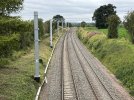
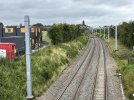



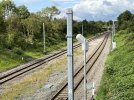


That's a great set of photos - thanks for posting.Looking north from the bridge near Newton Harcourt SPC7 Leicester Road/Newton Lane
View attachment 140429
and south and to the left, the compound for the rebuild of the same bridge.
View attachment 140430View attachment 140432View attachment 140433
== Doublepost prevention - post automatically merged: ==
Masts and cantilevers are up north of Market Harborough Station.
Looking north from the road bridge on Station Road Great Bowden. I could see just two masts beyond the foot bridge. I will investigate further during the week.
View attachment 140470View attachment 140471
south back towards the station.
View attachment 140472View attachment 140473

 www.linkedin.com
www.linkedin.com
